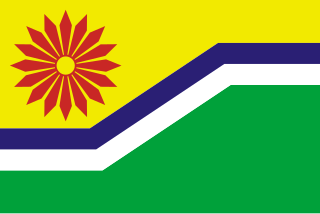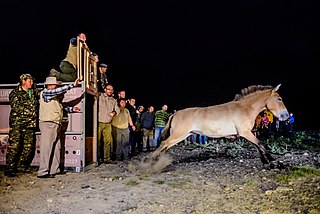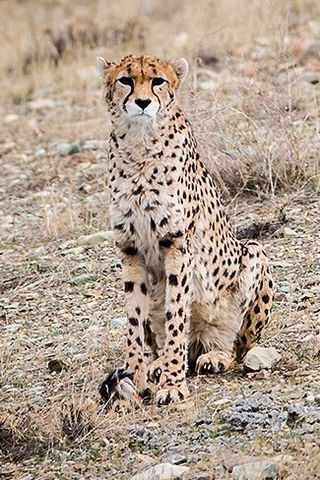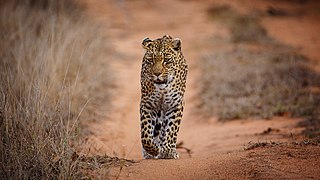Related Research Articles

Maasai Mara, also sometimes spelled Masai Mara and locally known simply as The Mara, is a large national game reserve in Narok, Kenya, contiguous with the Serengeti National Park in Tanzania. It is named in honour of the Maasai people, the ancestral inhabitants of the area, who migrated to the area from the Nile Basin. Their description of the area when looked at from afar: "Mara" means "spotted" in the local Maasai language, due to the many short bushy trees which dot the landscape.

Friederike Victoria "Joy" Adamson was a naturalist, artist and author. Her book, Born Free, describes her experiences raising a lion cub named Elsa. Born Free was printed in several languages, and made into an Academy Award-winning movie of the same name. In 1977, she was awarded the Austrian Cross of Honour for Science and Art.


Species reintroduction is the deliberate release of a species into the wild, from captivity or other areas where the organism is capable of survival. The goal of species reintroduction is to establish a healthy, genetically diverse, self-sustaining population to an area where it has been extirpated, or to augment an existing population. Species that may be eligible for reintroduction are typically threatened or endangered in the wild. However, reintroduction of a species can also be for pest control; for example, wolves being reintroduced to a wild area to curb an overpopulation of deer. Because reintroduction may involve returning native species to localities where they had been extirpated, some prefer the term "reestablishment".
Liwonde National Park, also known as Liwonde Wildlife Reserve, is a national park in southern Malawi, near the Mozambique border. The park was established in 1973, and has been managed by the nonprofit conservation organization African Parks since August 2015. African Parks built an electric fence around the perimeter of the park to help mitigate human-wildlife conflict. In early 2018, the adjacent Mangochi Forest Reserve was also brought under African Parks' management, almost doubling the size of the protected area.

The Asiatic cheetah is a critically endangered cheetah subspecies currently only surviving in Iran. It once occurred from the Arabian Peninsula and the Near East to the Caspian region, Transcaucasus, Kyzylkum Desert and northern South Asia, but was extirpated in these regions during the 20th century. The Asiatic cheetah diverged from the cheetah population in Africa between 32,000 and 67,000 years ago.

The Aspinall Foundation is a British charity which works to promote wildlife conservation. It was set up by casino owner John Aspinall in 1984 and runs the two zoos he established, Port Lympne Wild Animal Park and Howletts Wild Animal Park in Kent, England. It also runs conservation projects overseas to protect endangered species and return captive animals back to the wild. The charity is now run by Damian Aspinall, son of the founder.

The Timbavati Private Nature Reserve is located at the border line between Hoedspruit and Acornhoek, north of the Sabi Sand Private Game Reserve on the western edge of Kruger National Park. Geographically and politically, Timbavati is located in Mpumalanga Province. In Xitsonga, the name 'Timbavati' means "the place where something sacred came down to Earth from the Heavens", and refers to the rare white lions of Timbavati.

Majete Wildlife Reserve is a nature reserve in southwestern Malawi, established as a protected area in 1955. The reserve's animal populations were decimated during the late 1970s and 1980s due to poaching and other human activities. Majete has been managed by African Parks since 2003, when the nonprofit conservation organization entered into a public–private partnership with the Malawi Department of National Parks and Wildlife (DNPW). Since then, wildlife has been restored, the park has achieved big five game status, and tourism has increased.

African Parks is a non-governmental organization (NGO) focused on conservation, established in 2000 and headquartered in Johannesburg, South Africa. It was founded as the African Parks Management and Finance Company, a private company, then underwent structural changes to become an NGO called African Parks Foundation, and later renamed African Parks Network. The organization manages national parks and protected areas throughout Africa, in collaboration with governments and surrounding communities. African Parks manages 22 protected areas in 12 countries as of May 2023, and employs more than 1,100 rangers. Michael Eustace, Peter Fearnhead, Paul Fentener van Vlissingen, Anthony Hall-Martin, and Mavuso Msimang are credited as co-founders; Fearnhead continues to serve as chief executive officer. Prince Harry was appointed African Parks' president in late 2017.

Balule Nature Reserve is a protected area in Limpopo Province, South Africa which forms part of the Greater Kruger National Park as a member of the Associated Private Nature Reserves (APNR). As part of a wildlife conservation initiative, all fences separating APNR reserves – Balule, Timbavati, Klaserie, Umbabat, Grietjie Private Nature Reserve – and the Kruger National Park have been removed.

Londolozi Private Game Reserve is a large game reserve, with 15 000 hectares ; 42 000 acres; 58 sq mi) of land in northeastern South Africa. This means 1 bed per 167 hectares of land. Londolozi Rangers are not bound by Kruger Park rules and can therefore drive off-road on safari and conduct comprehensive bush walks into the wilderness. The reserve is part of the Sabi Sand Private Game Reserve, situated on the western border of Kruger National Park, which together with some other parks make up the Great Limpopo Transfrontier Park. Londolozi is a Zulu word meaning "Protector of all Living Things". Wildlife in this reserve includes the Big Five of Africa.
Erindi Private Game Reserve is a protected wildlife and ecological reserve in Namibia, southeast of the city of Omaruru. It is a private, fenced reserve located on the Namibian central plateau, populated with semi-open bush savannah and sparse, rugged mountains. The land on which Erindi was founded, has been reclaimed as part of a massive rehabilitation and conservation venture. The owners, Chris Joubert, and his brother Gert Joubert, originally bought the 70,719 hectares of land with the intention of going into cattle farming. It was soon realized that farming cattle is an extremely costly practice, and they abandoned the idea in favor of a private game reserve. The resulting aim was to restore endemic species to the area, with the intention that they would once again thrive there, and an ecotourism lodge and safari business would be built to provide income from the land.

Mudumu is a National Park in Caprivi Region in north-eastern Namibia. The park was established in 1990. It covers an area of 737 square kilometres (285 sq mi). The Kwando River forms the western border with Botswana. Various communal area conservancies and community forests surround Mudumu National Park.

Sabi Sand Game Reserve is located adjacent to the Kruger National Park in the Lowveld of Mpumalanga, South Africa. Officially named Sabi Sand Wildtuin, the Sabi Sand Game Reserve consists of a group of private game reserves. The Newington Gate is at 24°52′9″S31°24′16″E and west of the Kruger Gate and Skukuza camp of Kruger Park. Other entrances are Gowrie Gate in the far north and Shaws Gate in the south.

The Northeast African cheetah is a cheetah subspecies occurring in Northeast Africa. Contemporary records are known in South Sudan and Ethiopia, but population status in Eritrea, Djibouti, Somalia and Sudan is unknown.

The Southeast African cheetah is the nominate cheetah subspecies native to East and Southern Africa. The Southern African cheetah lives mainly in the lowland areas and deserts of the Kalahari, the savannahs of Okavango Delta, and the grasslands of the Transvaal region in South Africa. In Namibia, cheetahs are mostly found in farmlands. In India, four cheetahs of the subspecies are living in Kuno National Park in Madhya Pradesh after having been introduced there.

The Laohu Valley Reserve (LVR) is a nature reserve located near Philippolis in the Free State and near Vanderkloof Dam in the Northern Cape of South Africa. It is a roughly 350-square-kilometre private reserve.
Mapesu Private Game Reserve is a game reserve in Limpopo Province, South Africa. The reserve adjoins the Mapungubwe National Park and World Heritage Site, with which it shares a 12.5 km Northern border. The main entrance gate to the reserve is located approximately 7 km east of Mapungubwe's entrance gate. It was established in 2014 and covers an area of over 7,200 hectares. The reserve protects various bird, mammal and tree species and is slated to become part of the Greater Mapungubwe Transfrontier Conservation Area in phase 2 as part of the proposed Limpopo Valley Game Reserve.

The Dinokeng Game Reserve is a wildlife sanctuary in the province of Gauteng, South Africa and can be accessed via the N1 route. It is a 40-minute drive from Pretoria or 75 minutes from the O. R. Tambo Airport and Johannesburg. The reserve has the Big Five game animals, and is open for visitors to explore. It covers an area of approximately 21,000 hectares. The name, Dinokeng, is derived from the language of the Tswana and Bapedi people, and is translated as “a place of rivers”.
References
- ↑ De Bruyn, Pippa (26 February 2008). Frommer's South Africa - Pippa de Bruyn. p. 233. ISBN 9780470241943 . Retrieved 22 July 2013.
- ↑ "Facilitation of the Managed Cheetah Metapopulation". Endangered Wildlife Trust. Archived from the original on 6 May 2012. Retrieved 8 June 2023.
- ↑ "Home". Ace.nmmu.ac.za. Retrieved 22 July 2013.
- ↑ "Wits University". Wits.ac.za. Retrieved 22 July 2013.
- ↑ "Behaviour and Evolution Research Group". University of Lethbridge. Archived from the original on 28 January 2012. Retrieved 8 June 2023.
- ↑ "South Africa College of Tourism (SACT) Tracker Academy offers training courses in the skill of wildlife tracking and animal track identification leading to employment in the tourism industry". The Tracker Academy. Retrieved 22 July 2013.
- ↑ "Samara Private Game Reserve - Volunteer program". Samara.co.za. Retrieved 22 July 2013.
- ↑ "Home |". Vuyanisafehaven.co.za. Retrieved 22 July 2013.
- Brodowsky, Pamela K. (2009). Destination Wildlife: An International Site-By-Site Guide to the Best Places to Experience Endangered, Rare, and Fascinating Animals and Their Habitats. pp. 205–206. ISBN 9780399534867 . Retrieved 22 July 2013.
- "Samara Private Game Reserve". Condé Nast Traveler. Archived from the original on 22 July 2013. Retrieved 22 July 2013.
- "Samara Private Game Reserve, Photo 7 of 8". Condé Nast Traveler. Retrieved 22 July 2013.